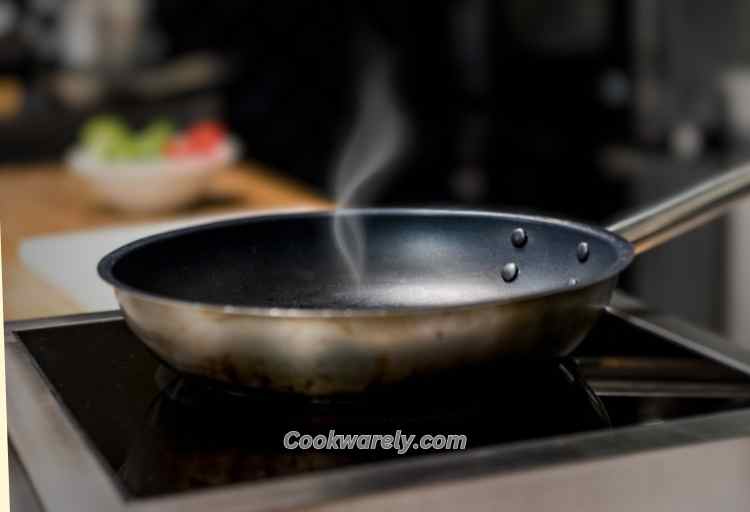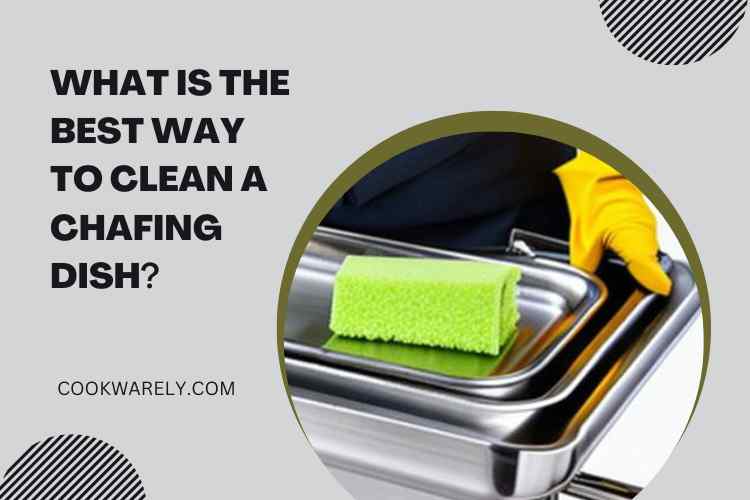Can Stainless Steel Pans Be Seasoned? Yes!
When it comes to cooking, the choice of cookware can significantly impact the outcome of your dishes. Stainless steel pans are a popular choice in many kitchens due to their durability and resistance to staining and rust.
Stainless steel pans can be seasoned to enhance nonstick properties, but unlike cast iron, it’s not mandatory. The process involves heating the pan, adding oil, and letting it smoke, creating a temporary nonstick layer. Stainless steel inherently resists sticking, so seasoning is optional.
Seasoning stainless steel pans is important as it enhances their nonstick properties, making cooking easier and improving their longevity.
To initiate the seasoning process for the stainless steel pan:
- First, Place the stainless steel pan on medium-high heat to open up its pores, preparing it for seasoning.
- Then, Apply a small amount of oil with a high smoke point (e.g., vegetable or canola oil) to the pan’s surface, spreading it evenly.
- Finally, remove the pan from heat once the oil smokes, allow it to cool, and use a paper towel to wipe off excess oil, resulting in a glossy, nonstick surface.
7 Considerations When Seasoning Stainless Steel Pans
| Consideration | Description |
|---|---|
| Purpose of Seasoning | Seasoning aims to create a semi-nonstick surface by polymerizing oil molecules on the pan’s surface, enhancing its cooking and cleaning properties. |
| Not Mandatory | Unlike cast iron or carbon steel, stainless steel pans can be used without seasoning, as they possess inherent resistance to sticking. |
| Temporary Enhancement | Seasoning provides a temporary boost in nonstick properties, but this may diminish over time with regular use, necessitating re-seasoning. |
| Choice of Oil | High-smoke point oils like vegetable, canola, or grapeseed oil are suitable for seasoning, ensuring they withstand the required high heat without breaking down. |
| Versatility Preserved | Seasoning doesn’t compromise stainless steel’s versatility; it remains suitable for various cooking methods and recipes. |
| Durability Maintained | The durability of stainless steel pans is preserved, with seasoning enhancing performance while maintaining the cookware’s long-lasting qualities. |
| Easy Cleaning | Seasoned stainless steel pans are still easy to clean, thanks to their smooth surface, but they may require gentler cleaning methods to preserve the seasoning. |
Key Takeaways
- When seasoning, opt for oils with high smoke points like vegetable or canola oil to prevent burning during the process.
- Ensure a thin, even layer of oil when seasoning to avoid excess buildup, which can become sticky over time.
- If you choose to season, periodically check the pan’s nonstick quality and re-season as needed to maintain its effectiveness.
- Don’t hesitate to use unseasoned stainless steel pans; they’re naturally nonstick. Experiment with different cooking techniques to find what works best for you.

What Is Seasoning in Cookware?
Seasoning, in the context of cookware, refers to the process of creating a semi-nonstick surface by polymerizing oil molecules on the pan’s surface.
This process forms a natural nonstick coating that makes cooking and cleaning easier over time.
While we often associate seasoning with cast iron pans, stainless steel cookware can also benefit from this treatment.
Can Stainless Steel Pans Be Seasoned?
Stainless steel pans can indeed be seasoned, although this process differs significantly from the seasoning of cast iron cookware.
Seasoning a stainless steel pan involves applying a thin layer of oil to its surface and subjecting it to high heat until the oil smokes and polymerizes, creating a nonstick layer.
While not mandatory, seasoning can enhance the pan’s nonstick properties, making it more effective for cooking foods that tend to stick, such as eggs or delicate fish. It also imparts a glossy finish to the pan, enhancing its aesthetics.
It’s crucial to note that stainless steel inherently resists sticking to a certain degree due to its smooth and polished surface. This natural nonstick quality is why seasoning is optional.
If you choose not to season your stainless steel pan, you can still enjoy its durability, versatility, and ease of maintenance. However, some cooks prefer seasoning for specific tasks or to achieve a smoother nonstick surface.
Why Does Seasoning Stainless Steel Pans matter?
Seasoning of a stainless steel pan matters for several reasons:
- Enhanced Nonstick Properties: Seasoning creates a semi-nonstick surface, reducing food adherence and making cooking and cleanup easier.
- Improved Performance: A seasoned pan distributes heat more evenly, preventing hot spots and allowing for consistent cooking results.
- Longevity: Properly seasoned pans can last longer, as the seasoning helps protect the stainless steel from corrosion and staining.
- Versatility: Seasoning doesn’t limit the pan’s versatility; it remains suitable for various cooking methods and recipes.
- Simplifies Cooking: Seasoning simplifies the cooking process, especially for delicate foods that require precise temperature control.
- Time-Saving: Seasoned pans reduce the need for excessive oil or fats in cooking, promoting healthier and quicker meal preparation.
How to Season Stainless Steel Pans?
Seasoning stainless steel pans is a straightforward process that can enhance their nonstick properties. Here’s a step-by-step guide to seasoning your stainless steel pan:
1. Preheating the Pan: Opening the Metal Pores
Before you start the seasoning process, it’s crucial to preheat your stainless steel pan. This step serves a vital purpose – it opens up the pores of the metal, making it more receptive to the oil and allowing for effective bonding. Follow these steps:
- Begin by placing your stainless steel pan on a stovetop burner set to medium-high heat.
- Allow the pan to gradually heat up. This process might take a few minutes, depending on your stovetop.
- The heat causes the metal to expand, which, in turn, opens up tiny pores on the pan’s surface.
2. Adding High Smoke Point Oil: The Choice Matters
Choosing the right oil is a critical aspect of the seasoning process. Opt for oils with high smoke points, such as vegetable oil, canola oil, or grapeseed oil. These oils can withstand the high heat required for seasoning without breaking down or developing undesirable flavors. Here’s how to do it:
- Once your pan is adequately preheated, add a small amount of your chosen high smoke point oil.
- It’s important not to overdo it. A little oil goes a long way in this process.
- Spread the oil evenly across the entire interior surface of the pan. You can achieve this by using a paper towel or a silicone brush.
3. Waiting for the Smoke: The Polymerization Process
Now, the seasoning process begins in earnest. The goal here is to heat the oil until it reaches its smoke point. This is where the magic happens, as the oil undergoes a chemical transformation known as polymerization, creating a natural nonstick layer. Follow these steps:
- Continue to heat the pan with the oil on medium-high heat.
- As the oil gets hotter, it will start to emit wisps of smoke. This is a clear sign that the oil is undergoing polymerization.
- The smoke point varies depending on the oil you’re using, but it generally falls within a specific temperature range. For example, canola oil has a smoke point around 400°F (204°C).
4. Cooling and Wiping: The Final Touch
Once you’ve achieved the smoking point, it’s time to complete the process. However, it’s essential to exercise caution, as the pan will be extremely hot. Here’s how to finish the seasoning:
- Turn off the heat and carefully remove the pan from the burner.
- Allow the pan to cool down naturally. Do not hasten the cooling process by running it under cold water, as this could cause the pan to warp.
- As the pan cools, the polymerized oil forms a nonstick layer on its surface.
- Once the pan is cool enough to handle, use a paper towel to wipe off any excess oil. This will leave you with a glossy, nonstick surface ready for your next cooking adventure.
Alternatives to Seasoning Stainless Steel
Seasoning stainless steel cookware is a well-known method to enhance nonstick properties, but it’s not obligatory for stainless steel pans.
Unlike cast iron or carbon steel, stainless steel inherently resists sticking due to its smooth surface, making it suitable for various cooking tasks without the need for seasoning.
This natural nonstick quality simplifies cooking and eliminates the necessity for extra treatments or periodic re-seasoning.
Stainless steel pans are versatile, durable, and easy to clean, accommodating different cooking methods and offering long-lasting performance.
While seasoning can enhance nonstick properties, stainless steel’s inherent qualities make it a reliable choice for those who prefer a hassle-free cooking experience without the seasoning process.
Considerations for Seasoning
It’s essential to understand that seasoning on stainless steel is temporary and not intended to be continuously built up like seasoning on cast iron pans. Here are some key considerations:
- Temporary Enhancement: Seasoning stainless steel provides a temporary boost in its nonstick properties. Over time and with regular use, this seasoning can wear off.
- Re-Seasoning: To maintain the nonstick surface, you may need to re-season your stainless steel pan periodically, especially if you frequently use it for high-heat cooking or if food begins to stick.
Benefits of Seasoning Stainless Steel
Why, then, would you consider seasoning your stainless steel pan? While it’s not mandatory, there are several benefits to doing so:
- Smoother Surface: Seasoning can result in a smoother cooking surface, making it easier to flip delicate foods like pancakes and omelets.
- Improved Nonstick Properties: Seasoning can enhance the natural nonstick properties of stainless steel, reducing the chances of food sticking to the pan.
Using Stainless Steel Pans Without Seasoning
If you choose not to season your stainless steel pan, rest assured that it can still deliver excellent cooking results. Here’s how to make the most of your stainless steel cookware without the seasoning process:
- Preheating: Before adding any ingredients, preheat your stainless steel pan. This step helps prevent food from sticking to the surface.
- Use Oil: Even without seasoning, you can achieve good nonstick results by using a small amount of cooking oil. Simply add a bit of oil to the pan before adding your ingredients.
You can enjoy effective cooking with stainless steel without the need for seasoning.
Frequently Asked Questions (FAQs)
Is Seasoning Necessary for All Stainless Steel Pans?
Seasoning is not mandatory for all stainless steel pans. Many stainless steel pans come with a naturally smooth cooking surface that doesn’t require seasoning. However, seasoning can be beneficial if you prefer a more nonstick cooking experience.
How Often Should I Re-season My Stainless Steel Pan?
The frequency of re-seasoning depends on how frequently you use your pan and the types of foods you cook. If you notice food sticking or a decline in the pan’s nonstick performance, it’s time to consider re-seasoning.
Conclusion
Seasoning stainless steel pans is an option, not a necessity. While it can provide benefits such as a smoother cooking surface and improved nonstick properties, stainless steel cookware can be effectively used without seasoning.
Preheating the pan and using a small amount of cooking oil can yield excellent results. Whether you choose to season or not, your stainless steel pan can continue to be a versatile and durable addition to your kitchen arsenal.
So, the next time you reach for that gleaming stainless steel pan, consider whether seasoning is right for you and your cooking style.





